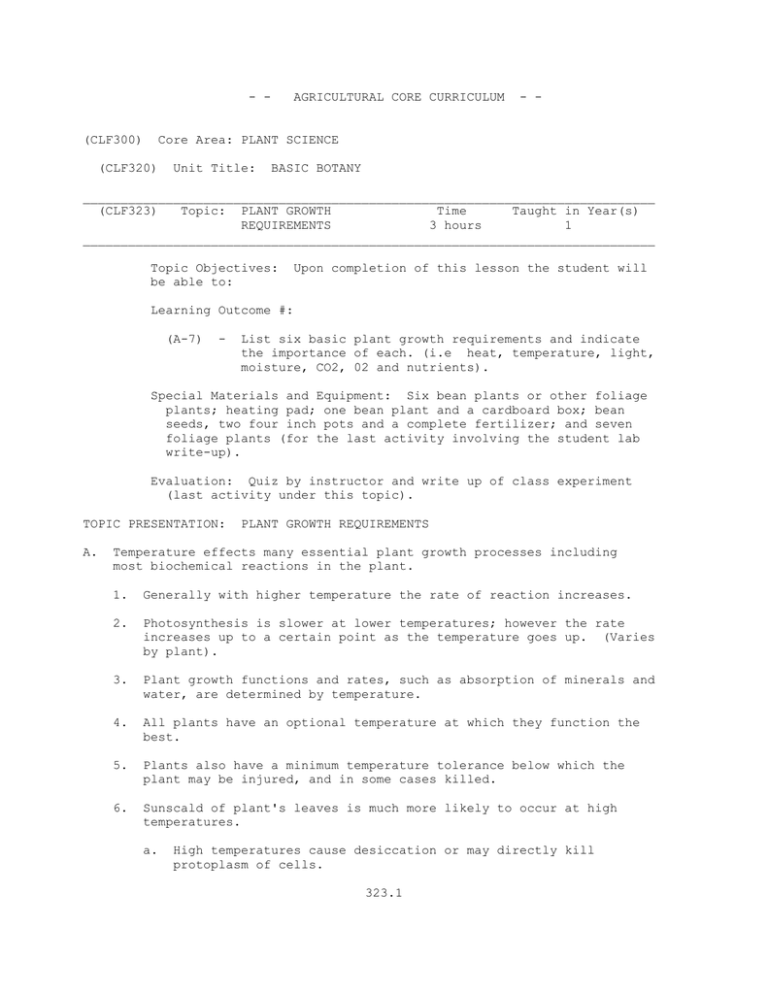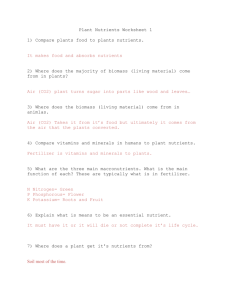CLF323
advertisement

- (CLF300) AGRICULTURAL CORE CURRICULUM - - Core Area: PLANT SCIENCE (CLF320) Unit Title: BASIC BOTANY ____________________________________________________________________________ (CLF323) Topic: PLANT GROWTH Time Taught in Year(s) REQUIREMENTS 3 hours 1 ____________________________________________________________________________ Topic Objectives: be able to: Upon completion of this lesson the student will Learning Outcome #: (A-7) - List six basic plant growth requirements and indicate the importance of each. (i.e heat, temperature, light, moisture, CO2, 02 and nutrients). Special Materials and Equipment: Six bean plants or other foliage plants; heating pad; one bean plant and a cardboard box; bean seeds, two four inch pots and a complete fertilizer; and seven foliage plants (for the last activity involving the student lab write-up). Evaluation: Quiz by instructor and write up of class experiment (last activity under this topic). TOPIC PRESENTATION: A. PLANT GROWTH REQUIREMENTS Temperature effects many essential plant growth processes including most biochemical reactions in the plant. 1. Generally with higher temperature the rate of reaction increases. 2. Photosynthesis is slower at lower temperatures; however the rate increases up to a certain point as the temperature goes up. (Varies by plant). 3. Plant growth functions and rates, such as absorption of minerals and water, are determined by temperature. 4. All plants have an optional temperature at which they function the best. 5. Plants also have a minimum temperature tolerance below which the plant may be injured, and in some cases killed. 6. Sunscald of plant's leaves is much more likely to occur at high temperatures. a. High temperatures cause desiccation or may directly kill protoplasm of cells. 323.1 1) 7. Protoplasm is another term for cytoplasm, which is a general term for the fluid and solids in cells. Plants should be selected according to the growth conditions and climate of the area. a. The exception is in greenhouses where temperature conditions can be controlled ____________________________________________________________ ACTIVITY: Place 3 containerized bean plants on a thermostatic heating pad set to 70 degrees, set 3 more plants next to these, just off of the heating pad. Make sure all of the plants get the water and light they need. After two weeks, compare the size of the plants in the two groups. ____________________________________________________________ B. Light effects plants based on its intensity, duration, and quality. 1. 2. QUALITY: The major source of light is the sun (greenhouses can use artificial light). a. Normal plant growth requires white light or sunlight. b. Chlorophyll absorbs the red and blue portions of the light spectrum and appear to be green, since the leaf reflects green light. c. Light quality is therefore important, and must contain important wavelengths (represented by the colors of the rainbow - visible to the eye in combination as white light) if being provided artificially. Light intensity provides energy for photosynthesis. a. The rate of photosynthesis is effected by the availability of water, CO2 and sunlight. b. In absence of light, plants will grow until their food reserves are exhausted. 1) 3. The growth will be elongated and abnormal. c. Phototropism in plants is the tendency to "lean" in the direction of the greatest light intensity. d. Plants vary in the intensity of light they need. Some plants such as Impatiens grow better in the shade with indirect light while others such as zinnias grow best in full sunlight. Light duration: 1. Photoperiodism is the growth response to the length of dark period. 323.2 a. 4. 5. This effects whether a plant is growing vegetatively or is in the flowering stage. (In a greenhouse, we can thus "force" a plant to bloom by controlling the duration of light ) Types of plants include, short-day, long-day and day-neutral plants. a. Poinsettia and Chrysanthemums require special time periods of light in order to initiate the blooming cycle. b. Azaleas can be forced to bloom sooner by adding light because they are long-day bloomers. c. Dandelion is a day plant and can initiate flowers under any day length. We can control light and influence blooming or vegetative growth by: a. Blackcloth to shorten days. This involves covering the growing plant with an opaque cover to exclude light. b. Artificial light. This simulates long days by adding light in the evening hours. ___________________________________________________________ ACTIVITY: Phototropism Demonstration Place a bean plant under a box with one side cut out. Check the bean plant the next day to see which direction it is leaning. Turn the box 180 degrees and have students observe what happens to the direction the plant leans after two more days. ___________________________________________________________ ___________________________________________________________ ACTIVITY: In the school garden have students plant a patch of sunflowers. Use plants started in the greenhouse, as soon as the danger of frost has passed. As flowers develop, have students observe the direction they face, and discuss the possible reasons for this. ___________________________________________________________ C. Moisture is another essential for plant growth: 1. Water carries essential nutrients from the roots and acts as a solvent for essential salts and minerals. 2. Water translocates photosynthetic products from the leaves via the phloem. 323.3 3. Water is a chemical reactant in many plant processes including photosynthesis. 4. Water provides turgidity by supporting the structure of herbaceous plants and adding cell tugor to all plant cells. 5. Water cools the plant during transpiration. 6. Water quality is important to plants. a. 7. 8. Excessive salts can cause leaf burn in (e.g.) Azaleas or Maples; root corrosion or death on (e.g.) Gardenias; or general poor seed germination, wilting of young seedlings and localized killing of leaves after contact with water high in salt. Capillary water is used by the plants. a. This water moves freely in the soil and can move up and down, or horizontally. b. An example of capillary action can be demonstrated by dipping the end of a napkin into a glass of water and observing the water as it move up through it. Forms of soil water not available to plants include: a. "gravity water" which is lost to drainage, and b. hygroscopic water that bonds to the soil particles. 1) This bonding is an electrical one related to the size of the soil particle and its electrical charge. a) 9. Plants with large thin leaf surfaces usually lose water more readily and have high water requirements (i.e.: tropical plants). a. Plants with small leaves and with waxy coatings, (cuticle) have a tendency to lose less water to transpiration and thus have lower H2O requirements. 1) F. The charge is opposite that of water and will attract or hold the water in the soil which makes it unavailable to the plant. Desert plants have small leaf surfaces while tropical plants usually have a large leaf surface. CO2 is required for photosynthesis. 1. CO2 is taken in through the stomata. 2. Air normally contains .03% carbon dioxide. In greenhouse conditions, CO2 can be added during bright winter days and in some instances a better crop can be grown. 323.4 a. For example, roses, carnations and tomatos raised in CO2 levels of 12% produced better crops. b. This can be accomplished by use of gas burners or the release of CO2 directly from tanks. G. There are 16 essential nutrients which plants use. They are (normally) available in the soil and are classified by their use. 1. The primary nutrients include potassium). 2. The secondary nutrients: magnesium). N, P, K (nitrogen, phosphorus and Ca, S, Mg (calcium, sulfur and 3. The trace or micro-nutrients Mn, Fe, Zn, Cu, Cl, B, Mo iron, zinc, copper, chloride, boron and molybdenum). (manganese, 4. Carbon, hydrogen, and oxygen are usually not limited since they are freely available in the air and water. (For more information on these nutrients, see CLF341) ______________________________________________________________ ACTIVITY: Germinate bean seeds in two 4 inch pots filled with washed sand, watering both pots with distilled water. One week after germination, add a small amount of a complete fertilizer, such as RAPID-GRO, to the irrigation water for one pot, and continue to water both groups of plants. Have students observe differences between the plants over the next 3 weeks. Ask students why washed sand was used for this experiment and what may have caused the visible differences between the two plants. ______________________________________________________________ ______________________________________________________________ ACTIVITY: Class experiment (demonstration) using seven plants and washed sand as the media: set up a single control while depriving each of the other six of one of the growth requirements including heat, light, primary nutrients, water. Then correct the deficiencies and rejuvenate plants to a healthy condition. Have the students describe the procedure, summarize the results, and discuss their observations, being sure to comment on WHY things may have happened as observed. Turn in the lab report for a grade. _____________________________________________________________ 323.5



